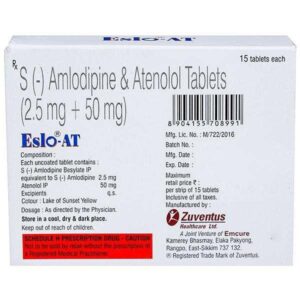AMLODIPINE + ATENOLOL
Amlodipine: Amlodipine is a prescription medication that belongs to the class of calcium channel blockers. It is commonly used to treat high blood pressure (hypertension) and chest pain (angina).
The primary mechanism of action of amlodipine is the inhibition of calcium ion influx through cell membrane channels in vascular smooth muscle and cardiac muscle. By blocking calcium influx, amlodipine helps to relax and widen the blood vessels, making it easier for blood to flow through them and reducing high blood pressure. It also increases the supply of oxygen to the heart by increasing blood flow.
The typical starting dose of amlodipine for hypertension is 5 mg orally once daily, which can be increased to a maximum dose of 10 mg per day if necessary. For the treatment of angina, the starting dose is usually 5 mg orally once daily. The dose may be adjusted based on the individual’s response and any other medications they may be taking.
Like any medication, amlodipine has potential side effects. Common side effects include dizziness, lightheadedness, flushing, headache, swelling in the ankles or feet (edema), and fatigue. These side effects are generally mild and may subside with continued use. However, if they persist or worsen, it is recommended to contact a healthcare provider.
In rare cases, amlodipine can cause more serious side effects such as a rapid or irregular heartbeat, severe dizziness or fainting, severe abdominal pain, and allergic reactions. If any of these serious side effects occur, immediate medical attention should be sought.
It is also important to note that amlodipine may interact with certain medications, including other blood pressure-lowering drugs, grapefruit juice, and certain antibiotics. Therefore, it is important to inform your healthcare provider about all the medications you are taking before starting amlodipine.
Overall, amlodipine is an effective medication for the treatment of hypertension and angina, helping to lower blood pressure and improve blood flow. However, it should be used under the guidance of a healthcare professional, and any concerns or side effects should be discussed with a doctor.
Atenolol: Atenolol is a medication that belongs to a class of drugs called beta-blockers. It is primarily used in the treatment of high blood pressure (hypertension), angina (chest pain), and certain heart rhythm disorders like atrial fibrillation.
Mechanism of action:
Atenolol works by blocking the activity of certain receptors in the body called beta-adrenergic receptors. By doing so, it reduces the effects of adrenaline (epinephrine) and other stress hormones on the heart. This leads to a decrease in heart rate and blood pressure, which helps to lower blood pressure and relieve symptoms of angina.
Dose:
Atenolol is available in tablet form and is usually taken once daily. The typical starting dose for hypertension is 50 milligrams (mg) per day, which can be increased to a maximum of 100 mg per day if necessary. For angina or heart rhythm disorders, the recommended dose may vary, and it is best to follow the instructions provided by a healthcare professional.
Side effects:
Common side effects of atenolol may include tiredness, dizziness, lightheadedness, slow heart rate, cold hands and feet, and gastrointestinal disturbances such as nausea and diarrhea. Some individuals may also experience difficulty sleeping, depression, or a decrease in libido. Atenolol can mask the symptoms of low blood sugar levels in individuals with diabetes, so it is important to monitor blood sugar levels regularly. In rare cases, atenolol can cause severe allergic reactions or have more serious side effects such as chest pain, shortness of breath, or swelling of the ankles or feet. If any severe side effects occur, medical attention should be sought immediately.
It is important to note that this is a general overview, and individual response to atenolol may vary. It is always recommended to consult with a healthcare professional for personalized advice and information specific to your situation.

